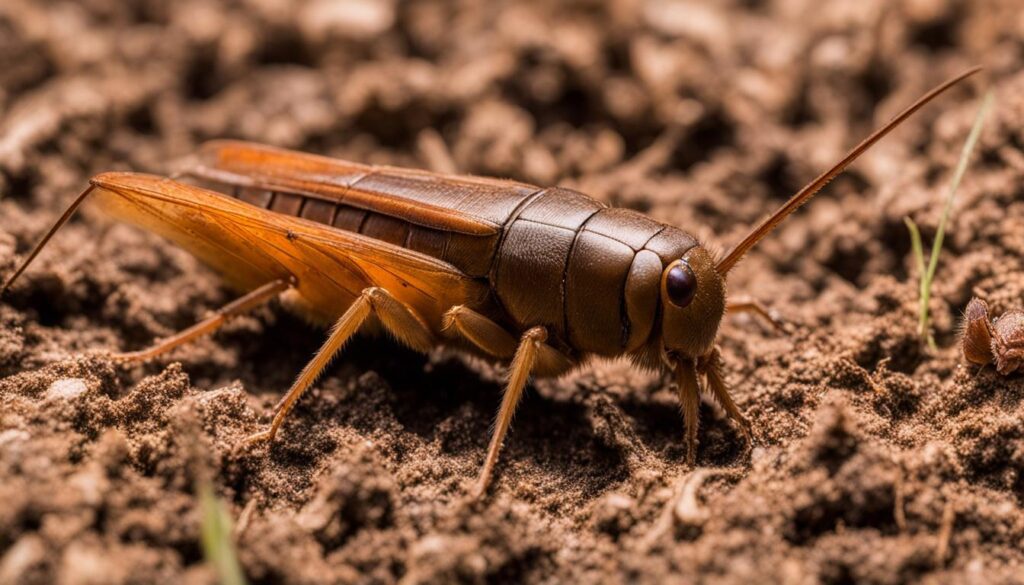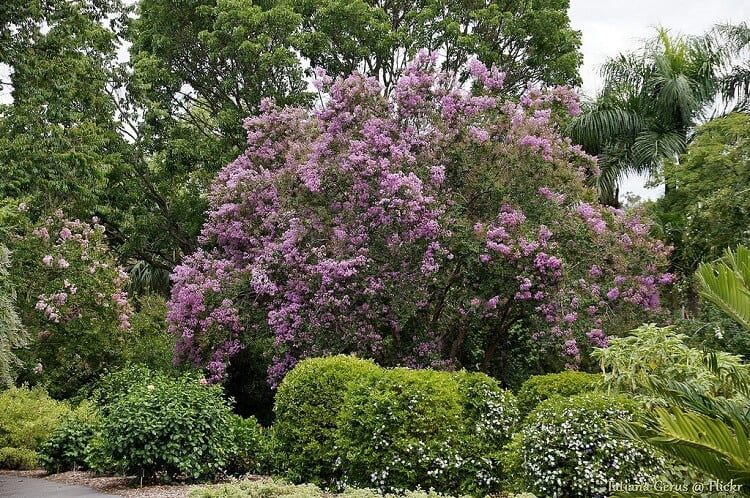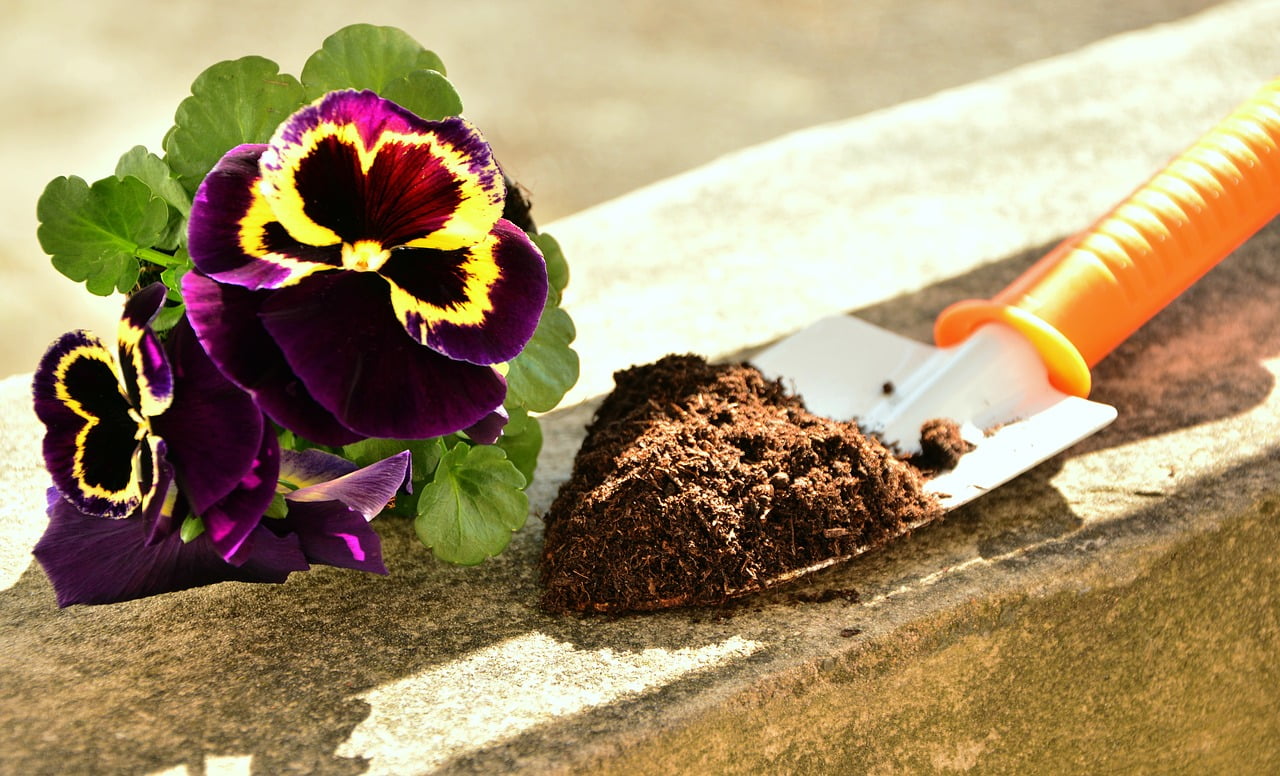Mole crickets can wreak havoc on your lawn, causing damage to the roots and stems of grass plants. If you’ve noticed small mounds of dirt, spongy areas, or brown and dying grass in your yard, you may have a mole cricket problem.
These destructive insects are most prevalent in the southeastern United States and can be challenging to eliminate due to their underground habits. However, with the right approach, you can control and get rid of mole crickets effectively.
To help you tackle this pesky issue, we’ve compiled essential information on identifying mole crickets and implementing control methods to restore the health of your lawn.
Key Takeaways:
- Mole crickets are destructive insects that can cause damage to lawns.
- Signs of mole crickets include small mounds of dirt, spongy areas, and brown, dying grass.
- The three main species of mole crickets in the southeastern United States are the short-winged mole cricket, the southern mole cricket, and the tawny mole cricket.
- Checking for and identifying mole crickets can be done by using a soapy water solution or observing their physical characteristics.
- To effectively control mole crickets, treat your lawn in early summer or at the first signs of damage and use insecticides specifically designed for mole crickets.
Types of Mole Crickets
In the southeastern United States, there are three species of mole cricket that can cause damage to lawns: the short-winged mole cricket, the southern mole cricket, and the tawny mole cricket.
The short-winged mole cricket is mainly found in southern Florida and southern Georgia. It is known for its short wings and the ability to fly short distances. Its body is brown and it has a small size compared to the other species.
The southern mole cricket can be found from North Carolina south to Florida and west to Arizona. It is known for its larger size and strong legs, which it uses for digging. Its body is dark brown or black, and it has long wings that enable it to fly.
The tawny mole cricket can be found from North Carolina to Louisiana and throughout Florida. It is the largest species of mole cricket and has a tawny or yellowish-brown color. It also has long wings and is capable of flying.
Signs and Damage Caused by Mole Crickets
Mole crickets can cause significant damage to lawns through their tunneling. Signs that you have mole crickets include small mounds of dirt scattered on the soil surface, a spongy feel to your lawn when you walk on it, and brown and dying grass in areas where mole crickets have tunneled. Mole crickets eat at night and can tunnel as far as 10-20 feet. The damage is most severe in young, newly planted lawns. Each species of mole cricket has a preferred food source, and certain turfgrasses are more susceptible to damage than others.
Having a healthy, well-maintained lawn is essential to prevent damage caused by mole crickets. Take note of these signs and act promptly to control mole crickets and minimize the effects on your lawn.
How to Check for and Identify Mole Crickets
To check for mole crickets in your lawn, you can use a simple and effective method. Prepare a soapy water solution by mixing approximately 2 tablespoons of dish soap in a gallon of water. Choose a small area of your lawn and pour the soapy water mixture over it. It’s best to do this in the early morning or late evening.
If you have mole crickets present, they will come to the surface of the soil within a few minutes, making them easily visible. This method helps in the identification process and confirms the presence of these destructive pests in your lawn.
Mole crickets can also be identified by their distinct appearance. They have large, beady eyes, spade-like front legs that are adapted for digging, and grayish-brown bodies. These characteristics make them unique and easily distinguishable from other insects.
Identifying mole crickets accurately is crucial for implementing effective control measures and protecting your lawn from further damage.
Remember to be cautious while handling your lawn, as mole crickets can quickly escape into the ground. Stay vigilant in your efforts to check for mole crickets regularly, especially during their peak activity periods.
How to Get Rid of Mole Crickets
Mole crickets can be a challenge to control due to their nocturnal nature and underground activity during the day. To effectively get rid of mole crickets and prevent further damage to your lawn, it’s important to take the appropriate measures in a timely manner. Early summer or at the first sign of lawn damage is the optimal time to treat your yard for mole crickets.
Mole crickets are most vulnerable during their nymph stage, so targeting them at this stage is crucial. One effective method to eliminate mole crickets is by using insecticides specifically designed for them. Ortho® BugClear® Lawn Insect Killer and Ortho® Home Defense® Insect Killer for Lawn & Landscape are two reliable options to consider. These insecticides are formulated to control and eliminate mole crickets, bringing relief to your lawn.
Prior to application, ensure that the soil is moist. This helps encourage the mole crickets to come to the surface, making it easier for the insecticides to reach and eliminate them. Follow the instructions and guidelines provided by the insecticide manufacturer for the best results. Remember to prioritize safety and use protective gear, if necessary, during the treatment process.
By taking proactive steps to control mole crickets in your yard, you can protect your lawn from further damage and maintain its health and appearance. Eliminating these destructive pests will ensure that your lawn thrives and remains a source of pride for you and your family.
Conclusion
Mole crickets are destructive pests that can wreak havoc on your lawn, causing significant damage. However, with the right strategies and treatments, you can effectively control and eliminate these troublesome insects.
To get rid of mole crickets, it is crucial to identify the signs early on. Look out for small mounds of dirt, spongy areas in your lawn, and brown, dying grass where the crickets have tunneled. Once you’ve confirmed their presence, it’s time to take action.
There are effective treatments available specifically designed for mole crickets. Utilize insecticides like Ortho® BugClear® Lawn Insect Killer or Ortho® Home Defense® Insect Killer for Lawn & Landscape, following the label instructions for application. Apply the insecticides when the soil is moist to encourage the crickets to surface.
In addition to using control methods, maintaining proper lawn care practices is essential. Ensure your lawn receives adequate irrigation and mowing, as a healthy lawn is less susceptible to mole cricket damage. By combining these efforts, you can keep your lawn free from mole crickets and maintain its lush, green appearance.
What is the Relationship Between Armadillos and Mole Crickets?
Armadillos often have a diet consisting heavily of mole crickets. This relationship can be problematic for those wishing to rid their property of mole crickets and prevent armadillo infestation. To deter armadillos, it is crucial to employ effective armadillo deterrence techniques to keep them from digging up lawns in search of mole crickets.
FAQ
How can I get rid of mole crickets?
To get rid of mole crickets, you can use insecticides specifically designed for mole crickets, such as Ortho® BugClear® Lawn Insect Killer or Ortho® Home Defense® Insect Killer for Lawn & Landscape. Treat your lawn in early summer or at the first sign of damage, and make sure the soil is moist before application to encourage mole crickets to come to the surface.
What are the types of mole crickets?
There are three species of mole crickets that can cause damage to lawns in the southeastern United States. These species are the short-winged mole cricket, the southern mole cricket, and the tawny mole cricket.
What are the signs and damage caused by mole crickets?
Signs that you have mole crickets include small mounds of dirt scattered on the soil surface, a spongy feel to your lawn when you walk on it, and brown and dying grass in areas where mole crickets have tunneled. Mole crickets tunnel through the soil near the surface and feed on the roots and stems of grass plants, causing significant damage.
How can I check for and identify mole crickets?
To check for mole crickets in your lawn, you can flush them out of the soil using a soapy water solution. Mix around 2 tablespoons of dish soap in a gallon of water and pour it over a small area of your lawn in the early morning or late evening. If you have mole crickets, they will come to the surface of the soil in a few minutes. Mole crickets can also be identified by their appearance, which includes large beady eyes, spade-like front legs for digging, and grayish-brown bodies.
How do I effectively control mole crickets?
Mole crickets can be difficult to control because they stay underground during the day and only surface at night. The best time to treat your lawn is in early summer or at the first sign of lawn damage. Mole crickets are most vulnerable when they are in their nymph stage, so it is important to treat them at this stage. Use insecticides specifically designed for mole crickets and follow the label directions for application. It is also important to maintain proper lawn care practices, such as proper irrigation and mowing, to keep your lawn healthy and less susceptible to mole cricket damage.
What are effective treatments for mole crickets?
Effective treatments for mole crickets include using insecticides specifically designed for mole crickets, treating your lawn in early summer or at the first sign of damage, and maintaining proper lawn care practices to keep your lawn healthy and less susceptible to mole cricket damage.











